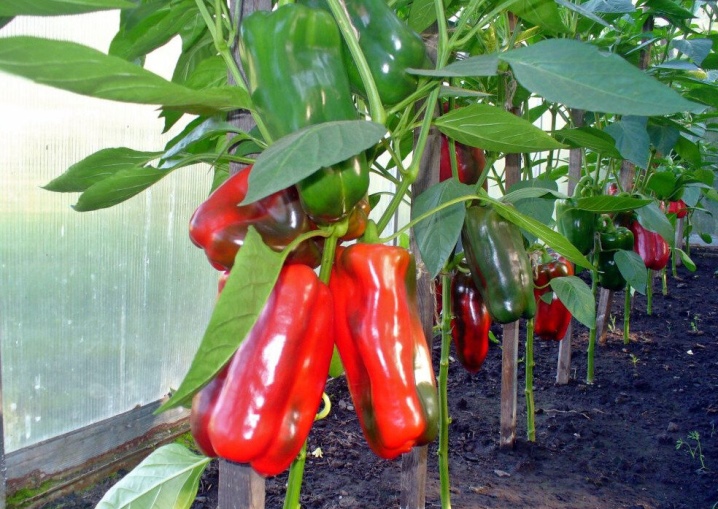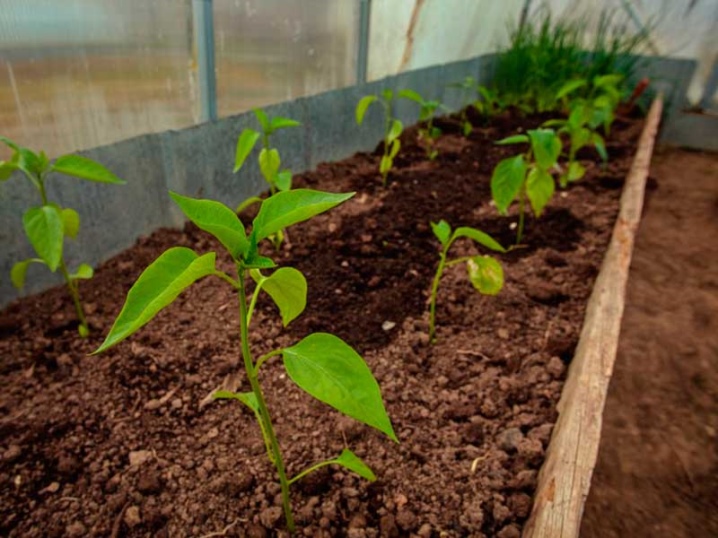How far to plant peppers in a greenhouse?

Sweet bell peppers are grown not only in different regions of Russia, but also far beyond its borders. It is a popular but whimsical vegetable crop that is demanding in terms of growing and care conditions.

The key to a successful harvest is not only regular watering and fertilization, but also choosing the right planting pattern.
Why is the landing pattern important?
Planting seedlings must be done in such a way, so that there is enough free space between the plants. Excessive density reduces yields and is bad for the condition of shrubs.

The need for a certain gap between plants is due to the following factors:
- Fresh air will freely circulate on the site, which will have a positive effect on the growth of seedlings;
- with a thickened planting in green mass dangerous pests are often found;
- fruits will not lack natural light, therefore, the color of the pepper will be bright, and the taste will be sweet and rich (when grown indoors, artificial light sources are used);
- a well-chosen and implemented scheme - pledge of good health of shrubs and prevention of fungus;
- enough free space is needed for comfortable plant care and harvesting.

Most novice gardeners underestimate the need to calculate the correct distance between plants, often violating the established rules of agricultural technology. However, experts say it directly affects the size of vegetables. Proper planting will make it easier to control dangerous pests that often attack the roots of fruit crops.

Also, at a certain distance, shrubs do not transmit fungal spores to each other, which is especially important when grown in greenhouses or greenhouses.
Growing pepper according to the scheme has the following advantages:
- a competent scheme will help to achieve maximum fruiting, especially when it comes to high-yielding varieties;
- shrubs take root quickly, and roots develop at an accelerated rate - if the distance between seedlings is insufficient, the roots grow very slowly and interfere with each other, as a result of which the development of shrubs slows down, and the yield drops noticeably;
- when placing seedlings on small plots, you can significantly save space and plant the optimal number of seedlings - Plants can be placed on the site compactly, while they will not interfere with each other.


Landing options
Types of circuits
Today, there are many schemes that modern gardeners use when planting peppers. Each of the options has certain features. Gardeners have compiled a list of the most common and effective planting schemes, evaluating their pros and cons.
When growing peppers in greenhouse conditions, one of the schemes listed below will work.
Traditional
When choosing this option, beds are made out with a width of one meter, and a minimum passage of 50 centimeters is left between them. Line planting means planting seedlings in two rows, between which they leave a gap of no more than 0.6 meters.
It is necessary to plant peppers in a polycarbonate greenhouse at a distance of 15 centimeters - the optimal gap between bushes of undersized varieties.When working with medium-sized seedlings, it is increased to 25 centimeters, and tall shrubs are planted at a distance of 40 centimeters from each other.

Square-nested
In this case, young plants are planted in small groups - 2-3 bushes in a planting pit with dimensions of 60x60 centimeters. A woody vine is poured into each hole before planting. It will serve as a top dressing in the early stages of plant development. This method is recommended for the southern regions, where the summer is long and hot.

Shrubs growing side-by-side are a natural defense to each other, protecting them from burns.
Chess
This option has long been popular among both beginners and experienced summer residents. In this case, they adhere to parameters such as 30x50 or 30x30 centimeters. The scheme is perfect for small areas, where it is important to correctly use every meter of the territory.
When choosing one of the schemes, it is imperative to take into account the method and frequency of irrigation. When establishing a large-scale plantation, it is advisable to use drip irrigation. It moderately and regularly moisturizes the soil, preventing it from waterlogging and drying out. In this case, you should make a choice in favor of a line landing. With the sprinkling method, seedlings are planted in a square-nested or checkerboard pattern.

The note! The organic space forces the planting to be compacted, leaving only 25 centimeters between the rows, and no more than 10 centimeters between the plants. This placement is not suitable for a rich harvest.
If planting seedlings is carried out in open ground, you need to choose one of the schemes that have been developed specifically for this growing method. Planting work is carried out in late spring or early summer. During this period, the air temperature does not drop below 15 degrees, even at night.
You need to decide on the distance between shrubs and rows before the day of disembarkation. Digging the planting holes, a gap of about 0.5 meters is left between them. Do not reduce the recommended distance, especially when working with tall shrubs. They grow rapidly and interfere with each other. A lot of space is needed for the free formation of side shoots. Young plants are placed in the holes, making out even rows. The soil in the planting pits is fed using minerals and organic matter.

Low seedlings are planted at a distance of about 50 centimeters. Such varieties form a large number of fruits on the side shoots, so you cannot get rid of them. Tall bushes need more space - 55 to 60 centimeters between bushes. These indicators are considered optimal, and the scheme can be changed depending on the characteristics of a particular variety.
When making a planting, you should correctly calculate the distance not only between plants, but also between the beds. Like many other vegetable varieties, peppers are planted in rows. For convenient and easy maintenance, it is advisable to make the beds as long as possible. The recommended size is about 60–70 centimeters.
If this condition is met, the gardener receives important advantages.
- Feeding peppers becomes very convenient. This applies both to foliar dressing and to preparations that are sprayed on leaves and shoots. With a comfortable planting, the plants will not be injured.
- In order to carry out watering in a timely manner, you also need to correctly place the seedlings in the selected area.... If desired, you can install any of the irrigation systems.
- Free access to each plant will allow you to harvest on time and monitor the state of maturity of vegetables.

Given the variety
The average planting rate of pepper may vary, taking into account the characteristics of the selected variety.
- Tall shrubs need more headroom than medium to short plants... The optimal distance is indicated above in the article.
- Also take into account the structure of the plant. Sprawling shrubs will take up more space on the site due to the special shape.
- If the variety forms fruit on the lower shoots, the distance between the rows must be increased.
- Some plants do not tolerate bright sunlight and grow well in shaded areas... When planting shrubs in darkened locations, they must be placed further away from each other.
- If the variety forms a large number of lateral shoots, this is also taken into account when choosing a suitable scheme.
- The gap between rows and seedlings can be shortened, if you are pruning excess growth or tying bushes.



Having stopped your choice on a specific variety, you should definitely familiarize yourself with agricultural technology. It should indicate not only information about the care, but also the recommended growing scheme.

The note! Leaving too large a gap between the rows and seedlings is also not worth it, especially if the branches are attached to supports for comfortable growing. If an irrigation system is installed on the site or in the greenhouse, the beds must be arranged in such a way that the plants receive the required amount of moisture. When watering by hand, the average distance is about 50 centimeters.
Useful Tips
Before planting shrubs in a greenhouse or in open areas, you should prepare the selected area. If necessary, it is leveled, cleaned of debris, weeds, and also fed. Mineral compounds or organic matter are used as fertilizers. If the acidity of the soil is elevated, it can be reduced with limestone or dolomite flour. Only after carrying out the preparatory work can you start digging holes.

If previously root crops or other fruit crops grew on the site, it is imperative to maintain a suitable distance between shrubs... Every centimeter of soil used needs to be additionally fed to replenish the amount of nutrients in the soil.

When growing in a greenhouse, the proximity to other plants (if any) should be taken into account. If the pepper grows too close to other crops, the root system will suffer and the size of the fruit will decrease.
It is also recommended to consider the following features of growing and planting pepper.
- Usually, it is recommended to transfer seedlings to open ground in the period from early to mid-May... The seedlings should be 60 days old and 25 centimeters high.
- Vegetable culture prefers light soil high in nutrients.
- You need to plant young plants in the evening, so that they do not suffer from sunburn.
- Average planting hole depth - about 15 centimeters.
- When symptoms of disease are detected you need to immediately get rid of the diseased plant or cure ituntil the infection spread to the rest of the shrubs.
















The comment was sent successfully.